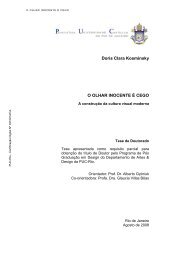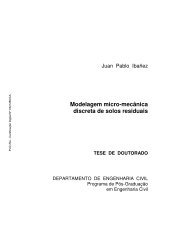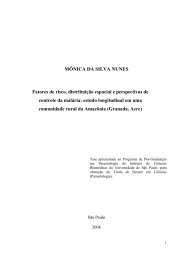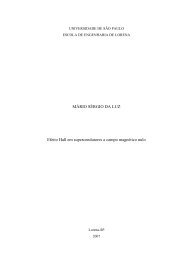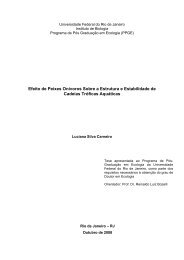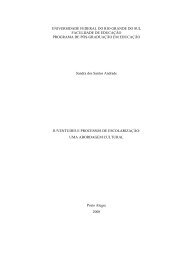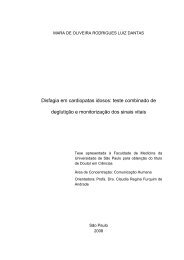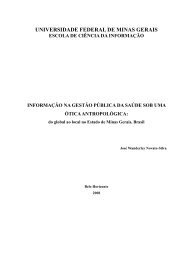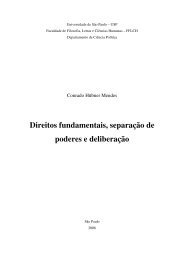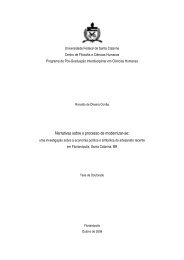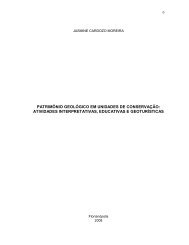R.S. Car<strong>do</strong>so et al. / Molecular Immunology 43 (2006) 464–472 471recombination of TRB8.1 [2,3]. The lymphotoxin A <strong>gene</strong>,accession no. NM010735, chromosome 17, codes for the tumornecrosis factor produced by lymphocytes. This protein iscytotoxic for a wide range of tumor cells in vitro and in vivo.Two <strong>gene</strong>s in cluster 6 are implicated in immune cell activation,cyclin D3 <strong>gene</strong> (CCND3, accession no. AK046638,chromosome 17) codes for a cdk6 protein kinase essentialfor the control of the cell cycle at the G1/S transition andearly growth response 1 <strong>gene</strong> (EGR1, accession no. M22326,chromosome 18) codes for a transcriptional regulator (earlygrowth response protein 1) that activates the transcription oftarget <strong>gene</strong>s whose products are required for mito<strong>gene</strong>sis anddifferentiation.Finally, we found <strong>gene</strong>s in this cluster closely implicatedin the V(D)J recombination mechanism of T-cell receptor<strong>gene</strong>s and immunoglobulins (Ig). The recombination activating<strong>gene</strong> 2 (RAG-2, accession no. AK040375, chromosome2) codes for recombinase 2, a component of the rag enzymaticcomplex (rag complex formed by rag-1 and rag-2 recombinases).This complex recognize and binds to the recombinationsignal sequences (RSSs) at the unrearranged TR or Igloci, consisting of conserved heptamer and nonamer motifsseparated by a spacer region of 12 or 23 bp.V(D)J recombination results in a precise head-to-head ligationof two signal sequences in a joint signal, which maycontain additions or deletions of a few bp. The reaction isinitiated by the formation of DSB, which is resolved by theDNA repair machinery, followed by an exonuclease and/orby terminal deoxynucleotidyl transferase (TdT) before formationof a coding joint.Mice that <strong>do</strong> not express RAG-1 or RAG-2 <strong>gene</strong>s are unableto form DSB and there is evidence that DNA DSB repairand V(D)J recombination share a partially common mechanism(Schlissel et al., 1993; Chaudhuri and Alt, 2004; Jeggoand Concannon, 2001).DNA-activated protein kinase <strong>gene</strong> (DNA-PK cs , accessionno. AK088981, chromosome 16), also present incluster 6, codes for a large polypeptide DNA-dependentprotein kinase catalytic subunit and its kinase activity isinvolved in DNA NHEJ required for DSB repair and V(D)Jrecombination. DNA-PK cs forms a complex with twosubunits of the heterodimeric Ku protein (Ku 70 and Ku 80)and must be bound to DNA to express its catalytic properties;cells that lack DNA-PK cs are radiosensitive and defectivein DNA repair, while DNA-PK cs null mice are viable butimmunodeficient, due to inability to complete V(D)J recombination(Lees-Miller and Meek, 2003; Pastwa and Blasiak,2003).The assembly of the DNA-PK cs complex to DNA ends isrequired for NHEJ binding step. Interestingly, the XRCC4repair <strong>gene</strong> was also observed in cluster 6, and the productof this <strong>gene</strong> was found to interact with DNA ligaseIV stimulating the ligase activity, in order to complete theNHEJ mechanism and probably the V(D)J recombinationprocess (Lees-Miller and Meek, 2003; Grawunder et al.,1997).Interestingly, the MMTV en<strong>do</strong>genous retrovirus (accessionno. BU515481, chromosome 19) is also present in thiscluster and displayed overexpression in irradiated FTOCs.We have previously shown an association between the expressionof MMTV and the parallel reduction of the TRBV8.1rearranged segment in vivo during the thymus ontogeny ofthe CBA/J strain (Espanhol et al., 2003).Finally, the DNA cross-link LR1 <strong>gene</strong> (DNA cross-linkrepair 1B, accession no. BC011094, chromosome 3F2.2),which codes for a protein involved in nucleotide excision repair,was induced in irradiated cultures. The deduced aminoacid sequence of its coded protein was about 30% similarto that of the Artemis protein (Moshous et al., 2001) and itsexpression pattern was similar to that of <strong>gene</strong>s implicated inV(D)J recombination, suggesting a possible role for this <strong>gene</strong>in this process.In conclusion, our results showed for the first time thatthe FTOC model system reproduces the in vivo developmentof the thymus regarding TRBV8.1-BD2.1 V(D)J recombination.Ionizing radiation, a potent physical agent capable of inducingDNA DSB, did not change the onset of recombinationbut increased the amount of the TRBV8.1-BD2.1 rearrangedsegment, suggesting a modulation of <strong>gene</strong>s involved in suchprocess.The hybridization signatures obtained with cDNA microarrayspermitted the identification of <strong>gene</strong>s modulatedduring gamma irradiation of FTOCs. Among them, we foundsome <strong>gene</strong>s related to the V(D)J recombination mechanismand we were able to pinpoint the DNA cross-link LR1 <strong>gene</strong>(DNA cross-link repair 1B) whose deduced protein sequenceis similar to that of the Artemis protein, and the RUNX3 andSOX4 <strong>gene</strong>s whose coded proteins bind to the enhancers ofT-cell receptor <strong>gene</strong>s.The present data obtained by application of the cDNA microarraymethod indicated several <strong>gene</strong>s participating in themechanism of V(D)J recombination and while some <strong>gene</strong>sare novel candidates, some others are important componentsfor the repair of DSB via NHEJ, thus strongly suggestingan overlap between the two processes. These results opennew perspectives for further studies on the specific roles ofthese <strong>gene</strong>s, using strategies of <strong>gene</strong> silencing, such as RNAinterference.AcknowledgementsThis research was supported by the Brazilian agenciesFundação de Amparo à Pesquisa <strong>do</strong> Esta<strong>do</strong> de São Paulo(Fapesp, #99/12135-9) and Conselho Nacional de DesenvolvimentoCientífico e Tecnológico (CNPq) and is part ofthe PhD thesis of RSC who received a pre-<strong>do</strong>ctoral fellowfrom Fapesp (#00/09994-9). We would like to thank Mrs.Geneviève Victorero, Mrs. Beatrice Loriod and Mr. FabriceLopez, Unité INSERM ERM 206, Marseille, France, for technicalassistance and discussions.
472 R.S. Car<strong>do</strong>so et al. / Molecular Immunology 43 (2006) 464–472ReferencesBertucci, F., Houlgatte, R., Granjeaud, S., et al., 2002. Prognosis of breastcancer and <strong>gene</strong> expression profiling using DNA arrays. Ann. N. Y.Acad. Sci. 975, 217–231.Chaudhuri, J., Alt, F.W., 2004. Class-switch recombination: interplay oftranscription, DNA deamination and DNA repair. Nat. Rev. Immunol.4, 541–552.DeLuca, D., Bluestone, J.A., Schultz, L.D., Sharrow, S.O., Tatsumi, Y.,1995. Programmed differentiation of murine thymocytes during fetalthymus organ culture. J. Immunol. Methods 178, 13–29.Eisen, M., Spellman, P., Brown, P., Botstein, D., 1998. Cluster analysisand display of genome-wide expression patterns. Proc. Natl. Acad.Sci. U.S.A. 95, 14863–14868.Espanhol, A.R., Car<strong>do</strong>so, R.S., Junta, C.M., Victorero, G., Loriod, B.,Nguyen, C., Passos, G.A.S., 2004. Large scale <strong>gene</strong> expression analysisof CBA/J mouse strain fetal thymus using cDNA-array hybridizations.Mol. Cell. Biochem. 260, 65–68.Espanhol, A.R., Mace<strong>do</strong>, C., Junta, C.M., Car<strong>do</strong>so, R.S., Victorero, G.,Loriod, B., Nguyen, C., Jordan, B., Passos, G.A.S., 2003. Gene expressionprofiling during thymus ontogeny and its association withTCRVB8.1-DB2.1 rearrangements of inbred mouse strains. Mol. Cell.Biochem. 252, 223–228.Fink, P.J., McMahan, C.J., 2000. Lymphocytes rearrange, edit and revisetheir antigen receptors to be useful yet safe. Immunol. Today 21,561–566.Fugmann, S.D., 2002. Breaking the seal. Nature 416, 691–694.Gontijo, A.M.M.C., Green, C.M., Almouzni, G., 2003. Repairing DNAdamage in chromatin. Biochimie 85, 1133–1147.Grawunder, U., Wilm, M., Wu, X., Kuleska, P., Wilson, T.E., Mamm,M., Lieber, M.R., 1997. Activity of DNA ligase IV stimulated bycomplex formation with XRCC4 protein in mammalian cells. Nature388, 492–495.Hempel, W.M., Stanhope-Baker, P., Mathieu, N., Huang, F., Schlissel,M.S., Ferrier, P., 1998. Enhancer control of V(D)J recombination atthe TCR beta locus: differential effects on DNA cleavage and joining.Genes Dev. 12, 2305–2317.Jeggo, P., Concannon, P., 2001. Immune diversity and genomic stability:Opposite goals but similar paths. J. Photochem. Photobiol. 65, 88–96.Junta, C.M., Passos, G.A.S., 1998. Emergence of TCR V(D)J recombinationand transcription during ontogeny of inbred mouse strains. Mol.Cell. Biochem. 187, 67–72.Lees-Miller, S.P., Meek, K., 2003. Repair of DNA <strong>do</strong>uble strand breaksby non-homologous end joining. Biochimie 85, 1161–1173.Lefranc, M.P., Lefranc, G., 2001. The T-cell Receptors Facts Book, firsted. Academic Press Suffolk, Lon<strong>do</strong>n.Mace<strong>do</strong>, C., Junta, C.M., Passos, G.A.S., 1999. Onset of T-cell receptorVB8.1 and DB2.1 V(D)J recombination during thymus developmentof inbred mouse strains. Immunol. Lett. 69, 371–373.Magalhães, D.A.R., Mace<strong>do</strong>, C., Junta, C.M., Mello, S.S., Marques,M.M.C., Car<strong>do</strong>so, R.S., Sakamoto-Hojo, E.T., Donadi, E.A., Passos,G.A.S., 2005. Hybridization signatures during thymus ontogeny revealsmodulation of <strong>gene</strong>s coding for T-cell signaling proteins. Mol.Immunol. 42, 1043–1048.Moshous, D., Callebaut, I., Chasseval, R., Corneo, B., Cavazzana-Calvo,M., Le Deist, F., Tezcan, I., Sanal, O., Bertrand, Y., Philippe, N.,Fischer, A., De Villartay, J.P., 2001. Artemis, a novel DNA <strong>do</strong>ublestrandbreak repair/V(D)J recombination protein, is mutated in humansevere combined immune deficiency. Cell 105, 177–186.Muegge, K., Vila, M.P., Durum, S.K., 1993. Interleukin-7: a cofactor forV(D)J rearrangement of the T-cell receptor <strong>gene</strong>. Science 261, 93–95.Nguyen, C., Rocha, D., Granjeaud, S., Baldit, M., Bernard, K., Naquet,P., Jordan, B.R., 1995. Differential <strong>gene</strong> expression in the murinethymus assayed by quantitative hybridization of arrayed cDNA clones.Genomics 29, 207–216.Pastwa, E., Blasiak, J., 2003. Non-homologous DNA end joining. ActaBiochim. Pol. 50, 891–908.Prise, K.M., Pinto, M., Newman, H.C., Michael, B.D., 2001. A review ofstudies of ionizing radiation-induced <strong>do</strong>uble-strand break clustering.Radiat. Res. 156, 572–576.Quackenbush, J., 2002. Microarray data normalization and transformation.Nat. Genet. 32 (Suppl.), 496–501.Rugh, R., 1968. The Mouse. Its Reproduction and Development. BurgessPublishing Company.Schlissel, M., Constantinesai, A., Morrow, T., Baxter, M., Peng, A.,1993. Double-strand signal sequence breaks in V(D)J recombinationare blunt 5 ′ -phosphorylated, RAG-dependent, and cell-cycle regulated.Genes Dev. 7, 2520–2532.Sollof, R.S., Wang, T.G., Dempsey, D., Jennings, S.R., Wolcott, R.M.,Chervenak, R., 1997. Interleukin 7 induces TCR <strong>gene</strong> rearrangementin adult marrow-resident murine precursor T cells. Mol. Immunol. 34,453–462.Tapias, A., Auriol, J., Forget, D., Enzlin, J.H., Scharer, O.D., Coin, F.,Coulombe, B., Egly, J.M., 2004. Ordered conformational changes indamaged DNA induced by nucleotide excision repair factors. J. Biol.Chem. 279, 19074–19083.Toki, J., Adachi, Y., Jin, T., Fan, T., Takase, K., Lian, Z., Hayashi, H.,Gershwin, M.E., Ikehara, S., 2003. Enhancement of IL-7 followingirradiation of fetal thymus. Immunobiology 207, 247–258.Verdeil, G., Puthier, D., Nguyen, C., 2002. Gene profiling approach toestablish the molecular basis for partial versus full activation of naïveCD8 T lymphocytes. Ann. N. Y. Acad. Sci. 975, 68–76.
- Page 1 and 2:
Universidade de São PauloFaculdade
- Page 3 and 4:
Macedo, ClaudiaO papel modulador do
- Page 5 and 6:
Dedico Especialmente este TrabalhoM
- Page 7 and 8:
AgradecimentosAgradeço do fundo do
- Page 9 and 10:
ÍndiceRESUMO .....................
- Page 11 and 12:
INDICE DE FIGURASFigura 1. Desenvol
- Page 15 and 16:
Promiscuous gene expression in medu
- Page 17 and 18:
INTRODUÇÃO1. INTRODUÇÃO1.1. A m
- Page 19 and 20:
INTRODUÇÃORecentemente surgiram e
- Page 21:
INTRODUÇÃOmigram para a região s
- Page 24 and 25:
INTRODUÇÃOCD4 + CD8 + , e Ccl21 (
- Page 26 and 27:
INTRODUÇÃOos timócitos duplo-pos
- Page 28 and 29:
INTRODUÇÃOgrande diversidade nas
- Page 30 and 31:
INTRODUÇÃOAs células mTECs são
- Page 32 and 33:
INTRODUÇÃODerbinski (2004). Os ti
- Page 34 and 35:
INTRODUÇÃOinvertebrados multicelu
- Page 36 and 37:
INTRODUÇÃOCoraçãoLínguaEstôma
- Page 38 and 39:
INTRODUÇÃO1.3. O papel do gene Au
- Page 40 and 41:
INTRODUÇÃOdefinido pela atividade
- Page 42 and 43:
INTRODUÇÃOpara abordarmos nossa p
- Page 44 and 45:
INTRODUÇÃOesses modelos levam em
- Page 46 and 47:
Hipóteses
- Page 48 and 49:
Objetivos
- Page 50 and 51:
Material e Métodos
- Page 52 and 53:
MATERIAL E MÉTODOSFigura 6. Padrã
- Page 54 and 55:
MATERIAL E MÉTODOScom estes RNAs f
- Page 56 and 57:
MATERIAL E MÉTODOSdos complexos de
- Page 58 and 59:
MATERIAL E MÉTODOSAo RNA total rec
- Page 60 and 61:
4.5. PCRs semi-quantitativas para o
- Page 62 and 63:
MATERIAL E MÉTODOSminutos a 4 °C.
- Page 64 and 65:
MATERIAL E MÉTODOS(Merck), soluç
- Page 66 and 67:
MATERIAL E MÉTODOSEnsaios de co-hi
- Page 68 and 69:
MATERIAL E MÉTODOSRNA TotalANELAME
- Page 70 and 71:
MATERIAL E MÉTODOSa) Preparação
- Page 72 and 73:
MATERIAL E MÉTODOScentrifugação
- Page 74 and 75:
MATERIAL E MÉTODOScanais (Cy3 e Cy
- Page 76 and 77:
MATERIAL E MÉTODOSSpotfinderQuanti
- Page 78 and 79:
MATERIAL E MÉTODOSOnde Xp(i) e Xc(
- Page 80 and 81:
MATERIAL E MÉTODOSO programa SAM p
- Page 82 and 83:
MATERIAL E MÉTODOSextrair automati
- Page 84 and 85:
DELINEAMENTO EXPERIMENTAL5. DELINEA
- Page 86 and 87:
RESULTADOS6. RESULTADOS6.1. Inibiç
- Page 88 and 89:
RESULTADOSPCR semiquantitativa gene
- Page 90 and 91:
RESULTADOS6.3. RT-PCRs semi-quantit
- Page 92 and 93:
RESULTADOS11.00%6,50%AdequadaNão A
- Page 94 and 95:
RESULTADOS6.6. Quantificação e no
- Page 96 and 97:
RESULTADOSPara um melhor entendimen
- Page 98 and 99:
RESULTADOSFigura 25. Agrupamento hi
- Page 100 and 101:
RESULTADOSFigura 26. Gráfico ilust
- Page 102 and 103:
RESULTADOS6.8. Influência do silen
- Page 104 and 105:
Discussão
- Page 106 and 107:
DISCUSSÃOA tolerância do repertó
- Page 108 and 109:
DISCUSSÃOCom relação à técnica
- Page 110 and 111:
DISCUSSÃOgene AIRE (do inglês aut
- Page 112 and 113:
DISCUSSÃOdesse modo a tolerância
- Page 114 and 115:
DISCUSSÃOPML (leucemia promielocit
- Page 116 and 117:
DISCUSSÃOBoehm et al. (2003) afirm
- Page 118 and 119:
DISCUSSÃOprograma Genenetwork (Wu
- Page 120 and 121:
Conclusões
- Page 122 and 123:
Referências Bibliográficas
- Page 124 and 125:
REFERÊNCIAS BIBLIOGRÁFICASBarthlo
- Page 126 and 127:
REFERÊNCIAS BIBLIOGRÁFICASDissert
- Page 128 and 129:
REFERÊNCIAS BIBLIOGRÁFICASGotter
- Page 130 and 131:
REFERÊNCIAS BIBLIOGRÁFICASMatsumo
- Page 132 and 133:
REFERÊNCIAS BIBLIOGRÁFICASby mito
- Page 134 and 135:
REFERÊNCIAS BIBLIOGRÁFICASRossi S
- Page 136 and 137:
REFERÊNCIAS BIBLIOGRÁFICASof thym
- Page 138 and 139:
Anexo I123
- Page 140 and 141:
ANEXO IEST IMAGE:582370 Expressed s
- Page 142 and 143:
ANEXO IDhps IMAGE:583332 Deoxyhypus
- Page 144 and 145:
ANEXO IMapkapk2 IMAGE:572979 MAP ki
- Page 146 and 147:
ANEXO IGm608 IMAGE:583350 Gene mode
- Page 148 and 149:
ANEXO ICcdc72 IMAGE:640628 Coiled-c
- Page 150 and 151:
ANEXO ITranscribed locusTranscribed
- Page 152 and 153:
ANEXO IEST IMAGE:583221 Expressed s
- Page 154 and 155:
ANEXO ITranscribed locusTranscribed
- Page 156 and 157:
ANEXO Irepair deficiency, complemen
- Page 158 and 159:
ANEXO Imember 1EST IMAGE:583824 Exp
- Page 160 and 161:
ANEXO ITranscribed locus IMAGE:5830
- Page 162 and 163:
ANEXO ITfdp1 IMAGE:640119 Transcrib
- Page 164 and 165:
ANEXO IEST IMAGE:583902 Expressed s
- Page 166 and 167:
ANEXO I2410022M11Rik IMAGE:640727 R
- Page 168 and 169:
ANEXO Icontaining 1Kif14 IMAGE:5836
- Page 170 and 171:
ANEXO Imember 3In multiple clusters
- Page 172 and 173:
ANEXO IEST IMAGE:639632 Expressed s
- Page 174 and 175:
ANEXO IAnkrd10 IMAGE:583740 Ankyrin
- Page 176 and 177:
ANEXO IEST IMAGE:641035 Expressed s
- Page 178 and 179:
ANEXO IVcam1 IMAGE:576563 Vascular
- Page 180 and 181:
ANEXO ITegt IMAGE:639877 Testis enh
- Page 182 and 183:
ANEXO I3Ehmt2Euchromatic histone ly
- Page 184 and 185:
ANEXO IEST IMAGE:583217 Expressed s
- Page 186 and 187:
ANEXO IEST IMAGE:640851 Expressed s
- Page 188 and 189:
ANEXO I20 homolog (yeast)Ube1c IMAG
- Page 190 and 191:
ANEXO IRasa3 IMAGE:582174 RAS p21 p
- Page 192 and 193:
ANEXO IEST IMAGE:640642 Expressed s
- Page 194 and 195:
ANEXO I4930566A11Rik IMAGE:583433 R
- Page 196 and 197:
ANEXO IEST IMAGE:640824 Expressed s
- Page 198 and 199:
ANEXO IEST IMAGE:582998 Expressed s
- Page 200 and 201:
Anexo II
- Page 202 and 203:
ANEXO II1500002B03RikIMAGE:1330385
- Page 204 and 205:
ANEXO IIEST IMAGE:640173 Expressed
- Page 206 and 207:
ANEXO IICnot10 IMAGE:576406 CCR4-NO
- Page 208 and 209:
ANEXO IIEST IMAGE:576142 Expressed
- Page 210 and 211:
Anexo III
- Page 212 and 213:
ANEXO III197Ifit1RelaIMAGE:575632Gr
- Page 214 and 215:
ANEXO III199Nde1Nol5aIMAGE:640341Rp
- Page 216 and 217:
Manuscrito da Tese
- Page 218 and 219:
MANUSCRITOAbstractThe expression of
- Page 220 and 221:
MANUSCRITOdominated the scenario in
- Page 222 and 223:
MANUSCRITOserum autoantibodies, all
- Page 224 and 225:
MANUSCRITOwere transfected with 10
- Page 226 and 227:
MANUSCRITOwere analyzed using the M
- Page 228 and 229:
MANUSCRITOpurified from ex vivo mou
- Page 230 and 231:
MANUSCRITOinformation theory as ARA
- Page 232 and 233:
MANUSCRITOKyewski B, Derbinski J, G
- Page 234 and 235:
MANUSCRITOBruno R, Sabater L, Tolos
- Page 236 and 237:
MANUSCRITOFigure 3. The gene expres
- Page 238 and 239: MANUSCRITOABFigure 5. Genetics netw
- Page 240 and 241: SÚMULACURRICULUM VITAE (Janeiro 20
- Page 242 and 243: ESTÁGIO NO EXTERIORSÚMULA• Labo
- Page 244 and 245: SÚMULAtranscript finishing initiat
- Page 246 and 247: SÚMULAlinhagens isogênicas de cam
- Page 248 and 249: SÚMULABOLSAS DE ESTUDO• Bolsa de
- Page 250 and 251: T cell signaling gene networks duri
- Page 252 and 253: IntroductionThe thymus is an import
- Page 254 and 255: ontogeny using such technology has
- Page 256 and 257: laboratory using a Generation III A
- Page 258 and 259: cDNA microarray data analysisStatis
- Page 260 and 261: Gene networksAs previously mentione
- Page 262 and 263: cells, including human herpesvirus-
- Page 264 and 265: gene was mostly indirectly positive
- Page 266 and 267: lymphocytes and finally associates
- Page 268 and 269: 4) Finally, Prrg2 was also identifi
- Page 270 and 271: 14. Kishimoto H, Sprent J (2000) Th
- Page 272 and 273: proliferation of a rat astrocyte ce
- Page 274 and 275: IMMUNOLOGYORIGINAL ARTICLEOnset of
- Page 276 and 277: Promiscuous gene expression in muri
- Page 278 and 279: Promiscuous gene expression in muri
- Page 280 and 281: Promiscuous gene expression in muri
- Page 282 and 283: R.S. Cardoso et al. / Molecular Imm
- Page 284 and 285: R.S. Cardoso et al. / Molecular Imm
- Page 286 and 287: R.S. Cardoso et al. / Molecular Imm
- Page 290 and 291: Molecular Immunology 42 (2005) 1043
- Page 292 and 293: D.A.R. Magalhães et al. / Molecula
- Page 294 and 295: D.A.R. Magalhães et al. / Molecula
- Page 296 and 297: Molecular and Cellular Biochemistry
- Page 298 and 299: 225Table 1. Target cDNA sequences a
- Page 300 and 301: 227coincided (CBA/J) with expressio



